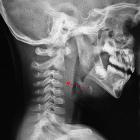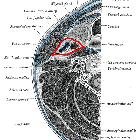Retropharyngealraum

The retropharyngeal space is a midline deep compartment of the head and neck that consists largely of fatty areolar tissue and lymph nodes that drain the pharynx, nose, and middle ear.
Terminology
The inferior extent of the retropharyngeal space can be confusing. Most commonly, including in this article, the term is used loosely to include its inferior continuation below the pharynx, surrounding the esophagus, and extending into the mediastinum. Some authors prefer the more general term retrovisceral space, in reference to its relationship to the visceral space . In turn, only the superior portion posterior to the pharynx is termed the retropharyngeal space, while the inferior continuation is the retroesophageal space.
The posterior extent of the retropharyngeal space can also be confusing. Between the visceral (buccopharyngeal) and prevertebral fascia, there are two spaces subdivided by a thin membrane known as the alar fascia. The anterior space is the "true" retropharyngeal space, described in this article, while the posterior one is the danger space . With anatomic studies highlighting the borders defined by the alar fascia, some authors treat the true retropharyngeal space as part of the visceral space . However, the alar fascia is not discernable on cross-sectional imaging . Therefore, many authors treat the combined spaces as one functional unit, termed the retropharyngeal space, which may have the danger space as a subcomponent or synonym .
Gross anatomy
The retropharyngeal space is posterior to the pharynx and esophagus, and extends from the base of the skull to the thoracocervical junction as the alar fascia attaches to the buccopharyngeal fascia (at a variable level between the C6 and T6 vertebral bodies) . The main component of the retropharyngeal space is areolar fat.
Lymph nodes are found in the portion of the retropharyngeal space above the hyoid bone, and these lymph nodes drain the pharynx, nasal cavity, paranasal sinuses and middle ears. These lymph nodes are prominent in children, and atrophy with age .
Contents
- areolar fat
- retropharyngeal lymph nodes
- small vessels
Relations
The retropharyngeal space is:
- anterior to the danger space
- posterior to the pharyngeal mucosal space
- anteromedial to the carotid space
- posteromedial to the parapharyngeal space
Boundaries
- anterior margin: middle layer of the deep cervical fascia
- posterior margin: alar fascia, which separates the retropharyngeal space from the danger space
- lateral margins: deep layer of the deep cervical fascia
- superior margin: clivus
- inferior margin: the point at which the alar fascia fuses with the middle layer of the deep cervical fascia, typically around the T4 vertebral body
Radiographic features
CT/MRI
The retropharyngeal space is a potential space which is directly related to the danger space, the pharyngeal mucosal space, the carotid space and the parapharyngeal space.
The retropharyngeal space appears as a small, roughly rectangular space on axial imaging, wider in the mediolateral dimension and thinner in the anteroposterior dimension. As fatty areolar tissue is the main component of the retropharyngeal space, it has a density consistent with fat on CT and a signal consistent with fat on MRI.
Because the alar fascia is very thin, it is difficult to differentiate the retropharyngeal space from the danger space on CT and MRI .
Related pathology
- head and neck squamous cell carcinomas
- obliteration of the retropharyngeal fat predicts involvement of the prevertebral fascia, which indicates locally advanced disease
- retropharyngeal abscess
- acute calcific prevertebral tendinitis
- metastatic adenopathy
- lymphoma
Siehe auch:
- verbreiterter prävertebraler Weichteilschatten
- carotid space
- retropharyngealer Abszess
- parotid space
- deep compartments of the head and neck
- masticator space
- retropharyngeale Raumforderung
- superficial mucosal space
- prevertebral space
- Parapharyngealraum
und weiter:

 Assoziationen und Differentialdiagnosen zu Retropharyngealraum:
Assoziationen und Differentialdiagnosen zu Retropharyngealraum:



